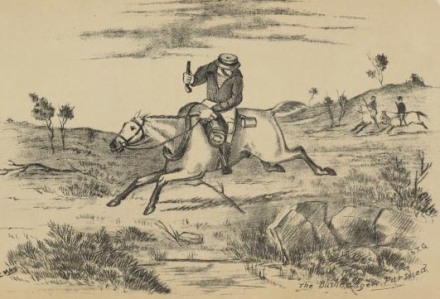These history notes are contributed to Valley Ventures by one of our members, Max Farley.
“Coyne’s Leap” has a place in the Yarramalong Valley’s legends. As is the case with legends, the actual facts are sketchy but John Coyne became legendary by leaping on horseback over a turpentine tree 2.75 metres in diameter while being pursued by two policemen also on horseback. This occurred 300 metres to the west of Wyong Creek School. The tree had fallen down from the adjoining steep hill and rested across the creek bed near the bridge that leads to the residences at 633-643 Yarramalong Road. The dry creek was the best path through the thick bush. The police were unable to make the leap themselves and Coyne vanished. He was described as a notorious “bushranger”. At that time the word “bushranger” not only meant the Ned Kelly variety but included all manner of persons stealing food and goods from homes and farmhouses.
The legend does not say when this happened but the Advocate reported (3 November 1977) that Matthew Woodbury had said the incident was in the 1840s. This is quite possible because bushrangers were active in Brisbane Water at the time. The legend also does not say why Coyne was being pursued. He may very well have been a bushranger. If the Leap was in the 1840s, it was not for murder because this did not enter the picture until 1855.
Research shows the most likely John Coyne was a 21 year old convict who arrived on the ship Portland (2) in 1833. He had been given a 7 year sentence having been tried in Galway.
The Leap was not the only reason John Coyne became part of the Valley’s history.
On 3 August 1855, Gosford Coroner J Harrison found that Mary Woolley, Robert Woolley’s 44 year old wife, had been murdered. Robert Woolley was a settler living with his wife where Woodbury’s Inn was later situated. The Woolley’s 5 year old child, named Robert after his father, was present while his mother was being murdered but he hid. Coyne was charged for her murder and sent to Sydney for trial. For reasons now obscure, he was not actually brought to trial but was discharged.
In May 1856 Coyne did stand trial for stealing a “draught chain” from the Ourimbah Sawmill Company. The evidence was that the chain had been stolen about 18 months previously – which would have been in about September 1854 and before the murder. It was known Robert Woolley was to be involved in the 1856 legal proceedings as a witness against Coyne. Coyne, knowing this, may have been badly disposed towards Woolley. Perhaps he merely confronted his wife in Robert’s absence and the situation got so out of hand that he ended up murdering her. This is conjecture but after 157 years it is not possible to know.
After these events John Coyne vanished from the records.
Time passed, and the next appearance of a John Coyne was in the Sydney Morning Herald on 12 March, 1872. It reported that “A woman named Aveline Littler was murdered while travelling in a cart to Windeyer on Wednesday. A man named John Coyne, or Conn, has been arrested on suspicion. A tomahawk stained with blood on it has been found, and in size corresponds with the cuts through the woman’s hat”.
On 3 June 1872 the Evening News reported that “John Conn, or Coyne, sentenced to death at the last sittings of the Criminal Court for having on the Mudgee Road, murdered a woman named Emmeline Littler, was hanged within the precincts of the (Bathurst) gaol at nine o’clock this morning. His head was severed by the fall”. The hanged man was 59 years old, the age that John Coyne, the 21 year old 1833 convict, would have been in 1872.
Writing in the Advocate of 20 July 1977, Edward Stinson said that “Some time later (after the Leap) Coyne was captured and put on trial… I have heard that his life came to an end when he was hanged in Bathurst Gaol”. The “some time later” could have been some 30 years later.
Robert Woolley Snr continued to live in the Wyong area for some years after his wife’s death and died in 1869. According to the Electoral Rolls their son, Robert, saw his life out in Cedar Brush Creek, Yarramalong and Lemon Tree. He died in 1925 and was buried in Yarramalong Cemetery. Stinson’s linking of the Woolley murder and the Bathurst hanging was not published until 52 years after Robert Jnr’s 1925 death.
Did Robert know that a man was hung in Bathurst in 1872 for a non-related murder and that man was his mother’s murderer? Did he have the comfort of knowing his mother’s murderer had met justice?
. . . . . . . . . . . . . . . . . . . . . . . . . . . . . . .
SOURCES: Max Farley; Illustration is a drawing entitled, The Bushranger Pursued by E.C. May [trove.nla.gov.au].

